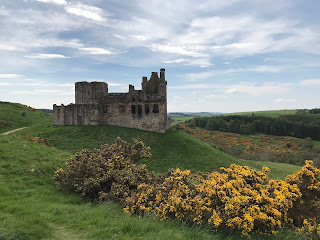Today I went for a wander out of Edinburgh and along to the ruins of Crichton Castle. The ruins sit just outside the village of Crichton, on a terrace that overlooks the picturesque scenery of the valley of the Tyne.
In
the Fourteenth Century a keep was built on this spot by the Crichton
family. In the Fifteenth Century the
castle building was extended around this by Sir William Crichton and then later
by others who had either inherited or were granted the castle and its lands. Sir Walter Scott wrote of the castle in his narrative
poem Marmion and also wrote a history of the castle, informing his
readers that – ‘it was built at different times, and with a very differing
regard to splendour and accommodation. The
older part of the building is a narrow keep, or tower, such as formed the
mansion of a lesser Scottish Baron; but so many additions have been made to it,
that there is now a large courtyard, surrounded by buildings of different ages. The eastern front of the court is raised
above a portico, and decorated with entablatures, bearing anchors. All the stones of this front are cut into
diamond facets, the angular projections of which have an uncommonly rich
appearance. The inside of this part of
the building appears to have contained a gallery of great length and uncommon
elegance. Access was given to it by a
magnificent staircase, now quite destroyed…’ Unfortunately, I didn’t get to see the
interior of the castle today, as it was closed due to Covid restrictions. However, I did find a drawing of the
courtyard.
The
first recorded owner, Sir William Crichton, was a man who was remarkable for
his time, having risen to prominence through politics rather than through
warfare. He became the Lord Chancellor
under King James I and later he also became the guardian of James II. He
was a man involved in various intrigues and his main claim to fame, or infamy,
would appear to be that he took part in organising the ‘Black Dinner’. This was when the Sixth Earl of Douglas and
his younger brother were invited to dine with young King James II and as they
ate were seized, dragged away and brutally murdered. Their great uncle, James Douglas, who had
also been involved in the plot against them, then inherited their wealth and
titles making him one of the most powerful men in Scotland at that time.
In
the early 1480s the Crichton family fell out of favour and their lands were
forfeited with the castle being given to Sir John Ramsay. He then fell out of favour and in 1488 the
castle was given to Patrick Hepburn, who later became the Earl of Bothwell. The castle stayed with Hepburn’s family for a
few generations, but in 1568 they fell out of favour, and it was again
forfeited. It was then handed over to Francis
Stewart, the ‘bastard’ grandson of James V. He carried out extensive work on the castle
including having the decorative diamond faced façade added in the courtyard and
a rather grand stable building built next to the castle. However, guess what, he was then accused of
witchcraft and plotting against King James VI.
He fled to Naples and in 1592 his properties, including the castle, were
forfeited. The castle was then
reinstated to Stewart’s son, and he sold it on to the Hepburn’s of Humbie. It
then passed through various owners who all seem to have just left it to crumble
and fall into ruin. The castle is now in
the care of Historic Environment Scotland.
I
left the Skulferatu that accompanied me on today’s walk in a crack in the wall
on the outside of the castle.
The
coordinates for the location of the Skulferatu are –
Latitude 55.839688
Longitude -2.991259
I
used the following sources for information on the castle –
The Castellated and Domestic
Architecture of Scotland from the Twelfth to the Eighteenth Century
Volume One
By David
MacGibbon and Thomas Ross
1887
The Ruined Castles of
Midlothian
By John Dickson
1894
The Scots Magazine and
Edinburgh Literary Miscellany
1st August 1808
Wikipedia – Crichton Castle












